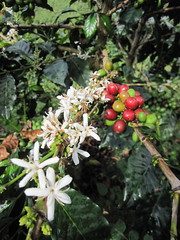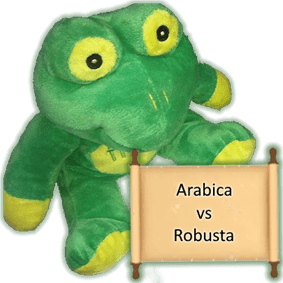Before reading the short summary below on Arabica varieties, we suggest you watch the video below to really get a handle on the number of varieties of Arabica:
Aaron Davis: Arabica – From Origin to Extinction
How many coffee species are there? I don’t know…
Arabica Varieties
Man has been directly or indirectly modifying the coffee bean since it was first smuggled out of the Yemen into Mysore India, and then taken back to Europe in the 1600’s. This has resulted in a large number or arabica varieties, that either developed naturally by a becoming ingrown like bourbon or by being exposed to similar plants like Robusta or Liberica trees.
 The direct process was driven by a need to allow coffee trees to grow in areas that made them susceptible to disease like coffee rust. The coffee market is now dominated by these varities today, there are over 40 varieties now, of which the purest is “typica”.
The direct process was driven by a need to allow coffee trees to grow in areas that made them susceptible to disease like coffee rust. The coffee market is now dominated by these varities today, there are over 40 varieties now, of which the purest is “typica”.
The closer the arabica variety is to the typica (the original Arabica from Ethiopia) the more flavoursome it is, and the harder it is to grow.
Arabica typica needs to be grown under a forest canopy, and typically at an altitude of over 1,600m and in a temperate climate, otherwise coffee rust develops preventing the tree to fruit, and even destroying the tree it self.
Home many varieties of Arabica
How many varieties of Arabica are there? See video above. We are not sure but here is a list of ones sampled and heard of.
- Acaia
- Agaro Kaffa (after the Kaffa region in Ethiopia)
- Agro Gimma Kaffa
- Anomala
- Anormalis
- Arabusta Alemania (guess which plant was used there ;))
- Augustigolia
- Barbuck Sudan
- Blue Mountain
- C. Liberica
- C. rasmosa
- canephora
- Castillo
- Caturra X Geisha
- Caturra
- Catimor
- Charrieriana
- Colombia
- Costa rica 95
- Erecta
- Garnica
- Geisha / Gesha
- Ihcafé 90
- K.7
- Kona
- Laurina
- Maracaturra
- Maragogype
- Moca
- Mundo nuvo
- Nana
- Pacamara
- Pacas
- Polisperma
- Purpurascens
- Ruiru 11
- Red boubon (from the island)
- resistant borbon
- RuiRu
- Sarchimor
- San Bernardo
- Semperflorens
- SL 28
- SL34
- Tabi
- Timot Hybrid (there are a number)
- UVA
- Verigado
- Villalosbos
- Wash Wash
- Yellow bourbon
- Yellow Cataui
- Zeguie
Well known arabica varieties:
| varietal | Notes |
|---|---|
| heirloom | Any coffee from Ethiopia is normally called this, it basically means there are too many varieties, but this is where Arabica coffee was first found. |
| typica | The original coffee found in Ethiopia, then grown in the Yemen originally, was smuggled to India where it was planted in Mysore area, where the Dutch traded and was then taken back to Holland |
| bourbon | Developed when the Arabica typica from India was kept in green houses in France and Spain, and was used as a source plant in South America, when the Spanish and Portugese started colonizing South Americas |
| caturra | A higher yielding mutation of bourbon, but has lost favour with mass produces since the 70’s |
| mundo nuvo | A mutation between typica and bourbon, that is more resistant, but fruits slower than the more popular varieties. Mainly produced in Brasil |
| catuai | A hybrid between of caturra and mundo nuvo made at The Institute of Agronomy, Campinas, Brazil in 1949. Most popular varietal with leading Italian blends |
Word Coffee Research
The WCR.org has started cataloging the different varieties as they can. You can read more here: varieties.worldcoffeeresearch.org.
Note: Kopi luwak is not a coffee variety but rather a method of processing the beans, that is quite similar to the wet processing method. We keep away from animal or environmental abuse as a standard, and since there is almost no Kopi Luwak harvested naturally any more, the only Indonesian coffee we do is Mandheling, which is a wet processed highland grown coffee



